|
|
MPIA Science Release 2012-10-30 |
|
| German version |
Dark clouds, young stars, and a dash of Hollywood
New results from space telescope's explorations of stellar birthplaces
An astronomical project led by researchers from the Max Planck Institute for Astronomy (MPIA) has examined the earliest stages of star formation in unprecedented depth: Using the European Space Agency's Herschel Space Telescope and techniques more commonly encountered in Hollywood blockbuster computer graphics than in astronomy, the researchers produced a three-dimensional map of the molecular cloud B68, a possible future birthplace for a low-mass star. Turning their attention to much more massive molecular clouds, the researchers also managed to identify a previously unobserved class of object that is likely the earliest known precursor of the birth of massive stars.
| Figure 1: False-colour image of the dark cloud Barnard 68, prepared using data from the Herschel Space Telescope at different far-infrared wavelengths. The way in which the cloud appears to change shape depending on wavelength is a sign of uneven external illumination. In the bottom left corner, there are traces of an isolated object. This could be a cloud fragment in collision with Barnard 68. The wavelengths for the images are 100, 160, 250 and 350 micrometers, respectively. The image colors show the intensity of the radiation received at that wavelength, from purple and blue at low intensity to high intensities in red and white. Image credit: MPIA / Markus Nielbock |
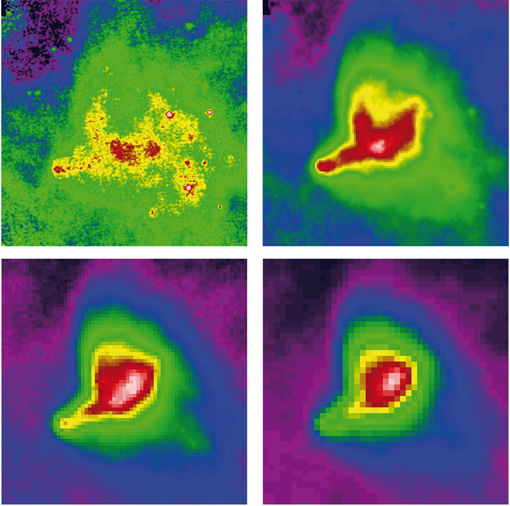 [Larger version for download] |
| Contact | Background information | Questions and Answers | Images |
Stars are born in hiding, when dense regions within clouds of gas and dust collapse under their own gravity. But the clouds not only provide the raw material for star formation, they also absorb most of the light from their interior, hiding from view the crucial details of stellar birth – one of the key astronomical processes if we want to understand our own origins!
Now, two groups in the EPoS ("Earliest Phases of Star formation") project led by MPIA's Oliver Krause, using ESA's Herschel Space Telescope, report new results in understanding the earliest stages of star formation.
On the trail of the origin of low-mass stars (with less than about twice the mass of our Sun), a team led by Markus Nielbock (MPIA) has completed a detailed investigation of one of the best-known potential stellar birthplaces: the dark cloud (or "globule") Barnard 68 in the constellation Ophiuchus. Combining the Herschel Space Telescope's unrivaled sharpness and sensitivity in the far-infrared range with a method more often encountered in visual effects companies working on Hollywood blockbusters than in astronomy, the researchers were able to construct the most realistic 3D model of the cloud to date.
The method, adapted for this particular use by MPIA's Ralf Launhardt, uses what is known as raytracing: For each minute portion of the object that we can see, the line of sight is traced back into the object itself. The contribution by each portion of the light's path – is light being absorbed at this particular point? is it being emitted? if yes, at which wavelengths? – are added up. Raytracing is routinely used to produce realistic-looking computer-generated creatures, objects or whole scenes. Here, it helped to match light emitted within Barnard 68 at different wavelengths with simplified models of the cloud's three-dimensional shape, density and temperature distribution.
The results have shaken up some of what astronomers thought they knew about this cloud. The emerging picture is one of Barnard 68 condensing from a drawn-out filament, heated by unevenly distributed external radiation from the direction of the central plane of our home galaxy. The astronomers also found some signs pointing to a cloud fragment in collision with Barnard 68, which might lead to the cloud's collapse, and the formation of one or more low-mass stars, within the next hundreds of thousands of years, and whose existence had been predicted by a previous study (Burkert & Alves 2009).
As cosmic clouds go, Barnard 68 is rather small. Clouds of this size will give birth to a few low-mass stars at most. To find out how massive stars are born (mass greater than about twice the mass of the Sun), a team led by MPIA's Sarah Ragan turned Herschel's PACS camera to 45 significantly more massive dark clouds. The clouds contain numerous stars about to be born, so-called "protostars". While previous missions, such as NASA's Spitzer Space Telescope, have also searched for protostars, Herschel enables astronomers to probe deeper into the clouds than ever before. Younger protostars are hidden much more effectively within their clouds than older ones. Herschel managed to find the youngest and most primitive protostars known.
The new observations swelled the ranks of known protostars from 330 to nearly 500 and, most excitingly, led to the discovery of a new type of not-quite-a-star: dense regions at a mere 15 degrees above absolute zero (-258 degrees Celsius) with no sign of a protostar. These regions are likely to be in an early precursor stage of star formation. In astronomy, where timescales of hundreds of millions or of billions of years are the norm, the fact that this precursor stage is expected to last less than 1000 years makes it extremely short-lived. Studying these elusive, pristine objects lays a necessary foundation for all subsequent studies of star formation.
| top |
Contact information
Markus Nielbock (lead author, Barnard 68 article)
Max Planck Institute for Astronomy
Phone: (+49|0) 6221 – 528 445
Email: nielbock@mpia.de
Sarah Ragan (lead author, massive stars article)
Max Planck Institute for Astronomy
Phone: (+49|0) 6221 – 528 458
Email: ragan@mpia.de
Markus Pössel (Public relations)
Max Planck Institute for Astronomy
Heidelberg, Germany
Phone: (+49|0) 6221 – 528 261
Email: pr@mpia.de
| top |
Background information
The results presented here have been published in Astronomy & Astrophysics as Nielbock et al., "The Earliest Phases of Star formation (EPoS) observed with Herschel: the dust temperature and density distributions of B68" and as Ragan et al., "The Earliest Phases of Star Formation (EPoS): A Herschel Key Program – The precursors to high-mass stars and clusters". The co-authors of the first publication are Markus Nielbock (Max Planck Institute for Astronomy: MPIA), Ralf Launhardt (MPIA), Jürgen Steinacker (Unviversité de Grenoble and MPIA), Amelia M. Stutz, Zoltan Balog, Henrik Beuther, Jeroen Bouwman, Thomas Henning (all MPIA), Pierre Hily-Blant (Université de Grenoble), Jouni Kainulainen, Oliver Krause, Hendrik Linz, Nils Lippok, Sarah Ragan (all MPIA), Christophe Risacher (SRON Netherlands Institute for Space Research and Max Planck Institute for Radio Astronomy and) and Anika Schmiedeke (MPIA and University of Cologne).
The co-authors for the second publication are Sarah Ragan (Max Planck Institute for Astronomy: MPIA), Thomas Henning, Oliver Krause, Jan Pitann, Henrik Beuther, Hendrik Linz, Jochen Tackenberg, Zoltan Balog (all MPIA), Martin Hennemann (AIM Paris-Saclay, CEA/DSM/IRFU – CNRS/INSU – Université Paris Diderot), Ralf Launhardt, Nils Lippok, Markus Nielbock (all MPIA), Anika Schmiedeke (MPIA and University of Cologne), Frederic Schuller (Max Planck Institute for Radio Astronomy), Jürgen Steinacker (Université de Grenoble and MPIA), Amelia M. Stutz (MPIA) and Tatyana Vasyunina (University of Virginia, Charlottesville).
The results are based on the Herschel Guaranteed Time Key Programme (GTKP) "The earliest phases of star formation (EPoS)" at the Max Planck Institute for Astronomy (MPIA). The project leader (principal investigator) is Oliver Krause. The project's low-mass part, including the research by Nielbock et al., is coordinated by Ralf Launhardt (MPIA). The high-mass part is coordinated by Henrik Beuther, Sarah Ragan and Thomas Henning.
Additional information:
• ESA Herschel pages
• MPIA Herschel pages
| top |
Questions and answers
Why are infrared, in particular far-infrared observations important for observing the birth of stars?
The clouds in which stars are born are opaque to ordinary, visible light. Visible-light observations can never tell us what is going on inside, and never show us the details of star birth. Fortunately, opacity depends on the kind of radiation in question. Where dust grains absorb ordinary, visible light, radiation known as infrared radiation – with much longer wavelengths than visible light, and closely related to the warming rays of a heat lamp – pass virtually unhindered. At the longest infrared wavelengths, there is far-infrared radiation, which carries information about the very heart of star formation regions – these regions are very cold, and what little light they do emit is in the far-infrared regime.
Such radiation is characteristic for very cool gas (around 10 K, or -263 degrees Celsius) in which the earliest phases of star formation take place, and for the somewhat warmer regions in which a protostar has already formed (around 100 K, or -173 degrees Celsius). Radiation emission is dependent on temperature: A stove plate with a temperature of the order of 100 degrees Celsius will emit radiation whose warmth we can feel on our skin. A light bulb, its filament at a temperature of a few thousand degrees, will emit visible light. The "thermal emission" of star formation regions of the temperature quoted, 10 degrees above absolute zero, is mainly in the far-infrared.
What is the importance of the Herschel Space Telescope for these studies?
We have learned in the previous question-answer pair that far-infrared radiation is the key to observing the early phases of star formation. The bad news is that it is much harder to discern small details when observing in the far-infrared rather than with visible light. For sharp viewing, you need large telescope. The other bad news is that far-infrared radiation reaching us from space is absorbed completely by the Earth's atmosphere. You need a telescope in space to observe this kind of radiation.
That is why ESA's Herschel Space Telescope (launched in 2009) is a key instrument for studies of star formation: with its 3.5 meter mirror (making it the largest current space telescope) and its highly sensitive far-infrared sensors mean that it can look inside dark clouds (far-infrared radiation!) and reveal details sharp enough (large mirror size!) for researchers to be able to create and test realistic models of star formation.
Which instruments were used in this study?
The researchers used the Herschel instruments PACS and SPIRE which, together, cover a wavelength between 70 und 500 µm (far-infrared radiation).
PACS (»Photodetector Array Camera & Spectrometer«) is a combination of camera and spectrograph for wavelengths between 57 and 210 µm. The instrument was developed and constructed by a consortium led by the Max Planck Institute for Extraterrestrial Physics in Garching, with key contributions by the Max Planck Institute for Astronomy in Heidelberg.
SPIRE (»Spectral and Photometric Imaging Receiver«) can produce images in wavelength bands centered on 250, 350 and 500 µm and produce spectra in the wavelength range between 200 and 670 µm. The instrument was developed and constructed by an international consortium led by the University of Cardiff.
| Figure 2: The Herschel Space Telescope (artist's impression) Image credit: ESA [Larger version for download] |
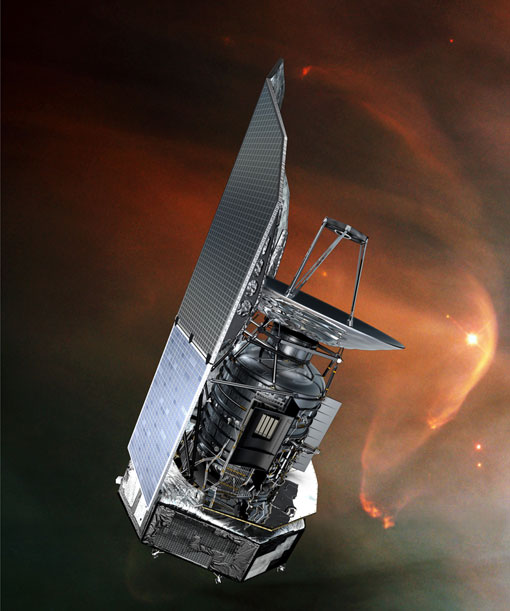 |
|
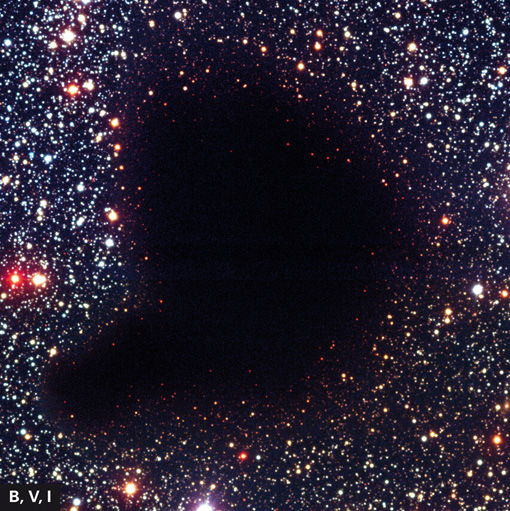 |
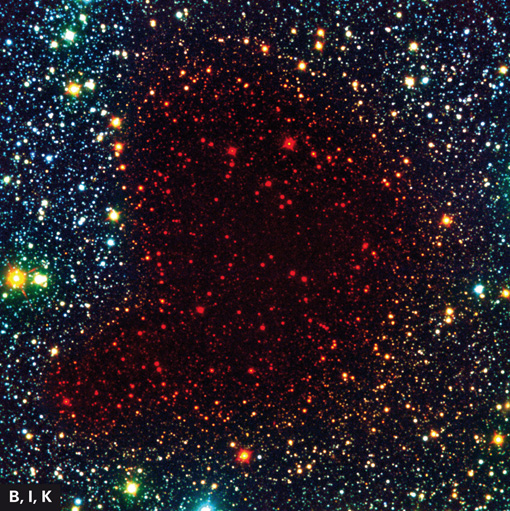 |
|
Figure 3: Images of the dark cloud Barnard 68 in visible light (left) and in the near-infrared (right). The images are not part of the EPoS study, but were taken using telescopes of the European Observatory (ESO). They illustrate very well the basic premises of infrared astronomy: In visible light, a dark cloud like Barnard 68 is opaque. Using infrared light, one can peer through the dark cloud, in this case revealing background stars. With mid- or far-infrared light, as in Fig. 1, one can obtain data about the structure of the cloud itself. Image credit: ESO [Larger version for download] |
||
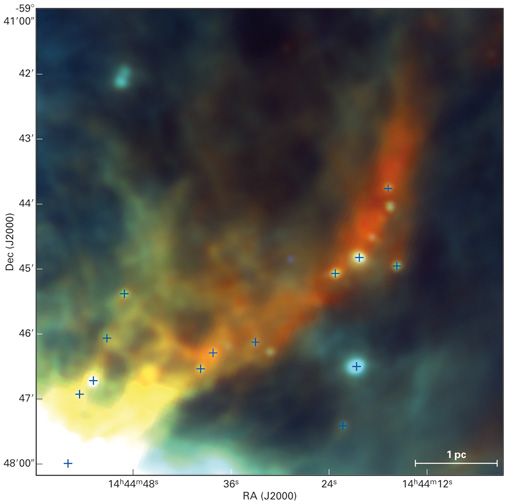
| ||
Figure 4: A false-color image of the molecular cloud IRDC316.72+0.07. Each "+" symbol indicates the presence of a protostellar core: a region that has started to collapse, but has not yet formed a new-born star. This is the first time these early stages of star formation have been observed. The image shows infrared data taken with the PACS instrument aboard the Herschel Space Telescope. The three colors represent three different wavelengths of far-infrared light: 70 micrometers [blue], 100 micrometers [green], and 160 micrometers [red]. Image credit: MPIA / S. Ragan [Larger version for download] |
||
| top |
Images
| with caption | |||||
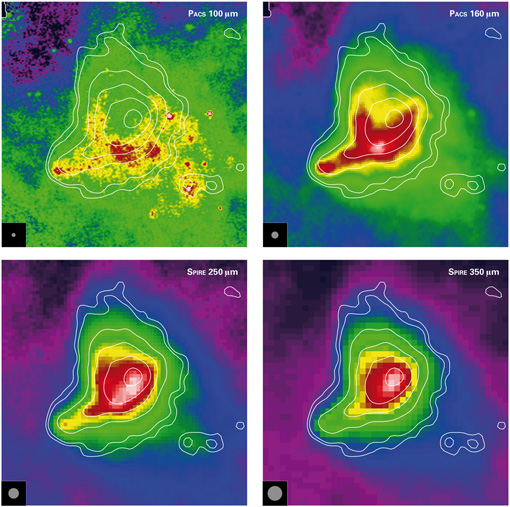 |
PR_121030_1.jpg | JPG | RGB | 510 x 507 | 147 KB |
| PR121030_1gr.jpg | JPG | RGB | 1200 x 1193 | 545 KB | |
| PR121030_1.pdf | CMYK | – | 315 KB | ||
| without caption | |||||
 |
PR_121030_1os.jps | JPG | RGB | 510 x 506 | 147 KB |
| PR121030_1os_gr.jpg | JPG | RGB | 1200 x 1190 | 545 KB | |
| PR121030_1os.pdf | CMYK | – | 344 KB | ||
 |
PR_121030_2.jpg | JPG | RGB | 510 x 611 | 57 KB |
| PR_121030_2gr.jpg | JPG | RGB | 1000 x 1198 | 197 KB | |
| PR_121030_2hr.jpg | JPG | RGB | 2000 x 2395 | 610 KB | |
 |
PR_121030_3a.jpg | JPG | RGB | 510 x 510 | 201 KB |
| PR_121030_3a_gr.jpg | JPG | RGB | 1000 x 1001 | 688 KB | |
 |
PR_121030_3b.jpg | JPG | RGB | 510 x 510 | 246 KB |
| PR_121030_3b_gr.jpg | JPG | RGB | 1000 x 1001 | 737 KB | |
 |
PR_121030_4.jpg | JPG | RGB | 510 x 504 | 49 KB |
| PR_121030_4gr.jpg | JPG | RGB | 1000 x 989 | 127 KB | |
| PR_121030_4.pdf | CMYK | – | 1 MB | ||
Press Releases 2012